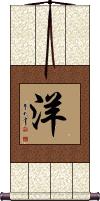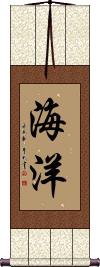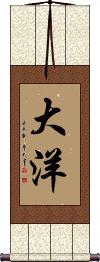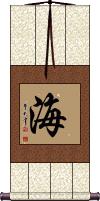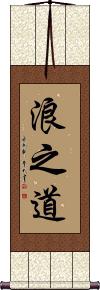The Name Ocean in Japanese/Chinese on a Custom-Made Wall Scroll.
Click the "Customize" button next to your name below to start your personalized ocean calligraphy artwork...
Ocean
Surname
Ocean
This is the Chinese and old Korean Hanja word for ocean. This can be pronounced in Japanese, and has the same meaning but is rarely seen alone in Japanese.
Besides ocean or sea, this character can also mean foreign, wide, or vast.
It's more common for Chinese people to use a different word “hai” for ocean or sea.
Ocean
海洋 is probably the most common word for “ocean” in Japanese. 海洋 is also sometimes used in Chinese and Korean Hanja.
In Japan, this can also be a female given name when pronounced as Miyou or Unami.
Great Sea
This is a rarely-used word for ocean in Japanese, Chinese, and Korean. This is here mostly for reference - please order a different ocean for your custom calligraphy wall scroll.
The first character means “big” or “great.”
The second means “ocean” or “body of water” (it can sometimes mean “foreign” but not in this case).
The first character designates that you are talking about a great or huge body of water (certainly a major ocean and not a smaller sea).
The Sea of Knowledge Has No Limits
學海無涯 is a Chinese proverb that reads, “sea of learning, no horizon.”
Colloquially, it means there are no limits to what one still has left to learn.
This would be the Chinese equivalent to the quote from Hippocrates, “ars longa, vita brevis,” meaning “it takes a long time to acquire and perfect one's expertise.”
See Also: Learning is Eternal
Ocean / Sea
海 is the character often used for sea or ocean in Chinese, Japanese Kanji, and old Korean Hanja. In some context, this can refer to the beach, or an area near the sea, such as “Shanghai” (same hai is the second character of Shanghai).
If you are looking for a universal word for ocean or sea - or can't decide which character for ocean or sea that you want, pick this one!
海 is also a common female given name in Japan - also a good name for a restaurant as “Umi Sushi” would mean “Ocean Sushi Restaurant.”
![]() Please note that our Japanese master calligrapher will tend to write this character in the form shown to the right (a line instead of two dots). Both versions are correct, and can be read in either language. Let us know if you have a preference when you order.
Please note that our Japanese master calligrapher will tend to write this character in the form shown to the right (a line instead of two dots). Both versions are correct, and can be read in either language. Let us know if you have a preference when you order.
The Way of the Wave
The Tao of the Waves
The following table may be helpful for those studying Chinese or Japanese...
| Title | Characters | Romaji (Romanized Japanese) | Various forms of Romanized Chinese | |
| Ocean | 奧申 奥申 | ào shēn / ao4 shen1 / ao shen / aoshen | ||
| Ocean | 洋 | you / yo | yáng / yang2 / yang | |
| Ocean | 海洋 | kai you / kaiyou / kai yo | hǎi yáng / hai3 yang2 / hai yang / haiyang | |
| Great Sea | 大洋 | tai you / taiyou / tai yo | dà yáng / da4 yang2 / da yang / dayang | ta yang / tayang |
| The Sea of Knowledge Has No Limits | 學海無涯 学海无涯 | xué hǎi wú yá xue2 hai3 wu2 ya2 xue hai wu ya xuehaiwuya | hsüeh hai wu ya hsüehhaiwuya |
|
| Ocean Sea | 海 | umi | hǎi / hai3 / hai | |
| The Way of the Wave | 浪之道 | làng zhī dào lang4 zhi1 dao4 lang zhi dao langzhidao | lang chih tao langchihtao |
|
| In some entries above you will see that characters have different versions above and below a line. In these cases, the characters above the line are Traditional Chinese, while the ones below are Simplified Chinese. | ||||

